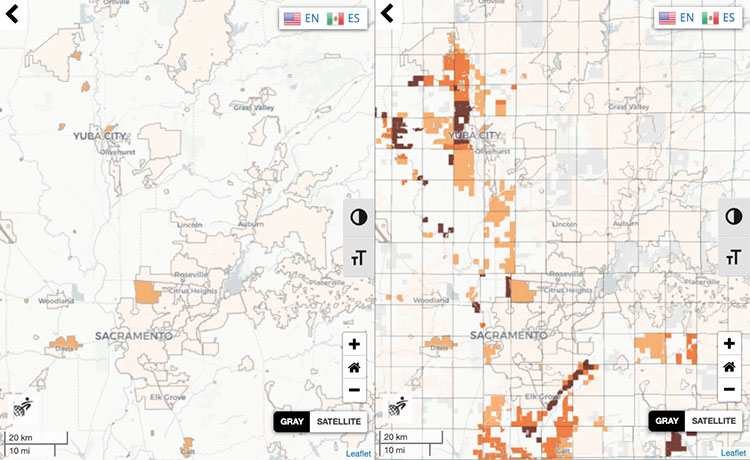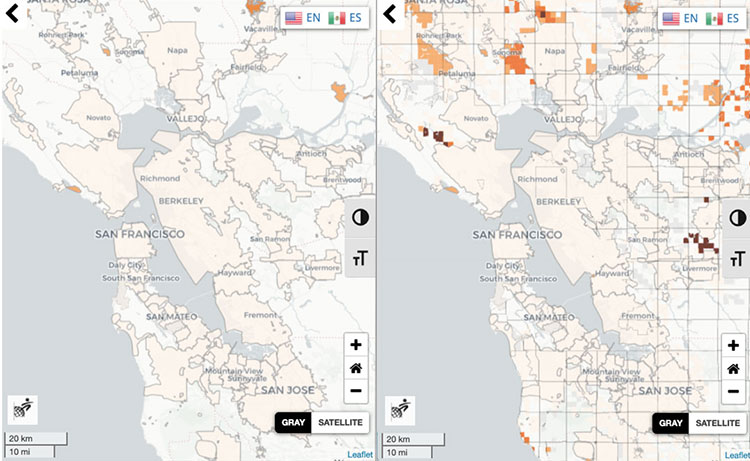Study: Safe drinking water remains out of reach for many Californians
The first comprehensive analysis of drinking water quality in California finds that 370,000 or more rely on drinking water that may contain unsafe chemical contaminants and communities of color are more likely to be impacted
January 11, 2022

The first comprehensive analysis of drinking water quality in California finds that 370,000 or more rely on drinking water that may contain unsafe chemical contaminants and that communities of color are more likely to be impacted. (Photos by Akira Hojo, Kayla Gibson, Ross Stone and mrjn Photography; UC Berkeley image by Neil Freese)
An estimated 370,000 Californians rely on drinking water that may contain high levels of the chemicals arsenic, nitrate or hexavalent chromium, and contaminated drinking water disproportionately impact communities of color in the state, finds a new analysis led by researchers at the University of California, Berkeley, and the University of California, Los Angeles.
Because this study is limited to three common contaminants, results likely underestimate the actual number of Californians impacted by unsafe drinking water from other compounds for which data are not as widely available, the researchers say.
Since 2012, access to safe, clean and affordable drinking water has been recognized as a human right in the state of California. Community water systems are required by federal regulations to undergo regular testing for contaminants that are harmful to human health. However, many California community water systems do not meet regulatory standards. In addition, many largely rural households receive their tap water from private domestic wells that remain largely unregulated.
This study, published in the current edition of the American Journal of Public Health, is the first to quantify the average concentrations of multiple chemical contaminants in both community water systems and domestic well areas statewide and is the first to systematically analyze demographic disparities in drinking water quality across the state.
The authors stress that addressing inequities in access to safe, clean drinking water will only become more urgent as climate change brings prolonged droughts and limits water availability in the state.

The team has created a Drinking Water Tool that allows Californians to find out where their drinking water comes from and map groundwater contamination with arsenic, nitrate, hexavalent chromium and 1,2,3-Trichloropropane. Screenshots of the tool show levels of arsenic contamination in Sacramento and Yuba City community water systems (left) and community water systems and domestic wells combined (right). (Maps generated by the Community Water Center Drinking Water Tool; UC Berkeley image by Kara Manke)
“California’s Human Right to Water Law articulates the right to clean and affordable drinking water for people served by both community water systems and domestic wells, but implementing this right is a significant challenge for people who rely on domestic wells because of the lack of regulatory infrastructure,” said study co-senior author Rachel Morello-Frosch, a professor of public health and of environmental science, policy and management at UC Berkeley. “Our data strongly indicate that a large number of people who rely on domestic wells are likely drinking water with high levels of contaminants and suggest locations where we should begin targeted assessments to ensure that the human right to water is fully implemented.”
To conduct the study, the researchers combined data on the state’s community water systems, domestic well permits, residential tax parcels, building footprints and census results to locate California households likely to be served by unregulated domestic wells. They then used measurements of drinking water and groundwater contamination throughout the state to estimate contaminant levels for those served by both community water systems and domestic wells.
The study focused on three chemical contaminants based on their prevalence in the state, as well as on their known toxicity. Arsenic is found naturally in groundwater and can be concentrated by depletion of the water table. Nitrate contamination of groundwater is common in agricultural regions due to fertilizer runoff and industrial animal farming. Hexavalent chromium is produced by industrial and manufacturing activities.
According to the analysis, approximately 1.3 million Californians — nearly 3 1/2% percent — rely on domestic wells for their water supply. Of the estimated 370,000 Californians whose water supply was found to likely contain high concentrations of arsenic, nitrate or hexavalent chromium, more than 150,000 are served by domestic wells. Information on domestic well water quality continues to be lacking, but closing this data gap is crucial to ensuring all Californians know what is in their water and if it is safe to drink, the researchers say.
“I think a lot of people might be surprised to learn that, given how wealthy the state of California is, we still don’t have universal access to clean drinking water,” said study co-senior author Lara Cushing, an assistant professor of environmental health sciences at UCLA. “For the three chemical contaminants that we looked at, we found that places with a higher proportion of people of color experienced greater levels of drinking water contamination. This pattern has already been documented in community water systems, particularly in the San Joaquin Valley, but our work is one of the first to examine the question statewide and among domestic well communities not served by public water systems.”
The study was carried out by UC Berkeley and UCLA scientists in collaboration with researchers at the California Environmental Protection Agency (CalEPA) and the Community Water Center. The team has released an online Drinking Water Tool that policymakers and members of the public can use to look up where their water comes from, as well as map areas of the state where groundwater sources are likely contaminated with unsafe levels of arsenic, nitrate, hexavalent chromium and 1,2,3-Trichlorolopropane.

The study uses geospatial data to estimate groundwater contamination in both community water systems and smaller domestic wells, the latter of which remain largely unregulated. Screenshots from the Drinking Water Tool show levels of arsenic contamination in San Francisco Bay Area community water systems (left) and community water systems and domestic wells combined (right). (Maps generated by the Community Water Center Drinking Water Tool; UC Berkeley image by Kara Manke)
“The goal of the Drinking Water Tool is to provide timely access to data that can inform efforts to protect the state’s drinking water and groundwater supplies, particularly in disadvantaged communities where the threats are greatest,” said study first author Clare Pace, a postdoctoral scientist at UC Berkeley. “We’d like to continue to refine the Drinking Water Tool in collaboration with the Community Water Center and in response to feedback from other organizations and decision-makers who can help ground-truth the data.”
The tool also allows users to compare drinking and groundwater quality information with data on community demographics across the state and models how drought conditions may impact water availability for domestic wells and community water systems that serve fewer than 10,000 people.
“In this era of climate change, our groundwater is becoming an increasingly precious resource, and we’re facing historic levels of drought and well failures. Even if a well doesn’t fail, drawdown of the water table can impact water quality by concentrating contaminants, making these problems even worse,” Cushing said.
Co-authors of the study include Carolina Balazs and Komal Bangia from the CalEPA Office of Environmental Health Hazard Assessment, Nicholas Depsky from UC Berkeley and Adriana Renteria, previously of the Community Water Center. This work was supported by the National Institute of Environmental Health Sciences (NIEHS), Award P42ES004705, and by a California Proposition 1 Sustainable Groundwater Planning Grant Award 4600012684.
RELATED INFORMATION
- Inequities in drinking water quality among domestic well communities and community water systems, California, 2011-2019 (American Journal of Public Health)
- Community Water Center Drinking Water Tool